engine Oldsmobile Aurora 1998 s Owners Manual
[x] Cancel search | Manufacturer: OLDSMOBILE, Model Year: 1998, Model line: Aurora, Model: Oldsmobile Aurora 1998Pages: 380, PDF Size: 19.75 MB
Page 281 of 380

What to Add
When you do need brake fluid, use only DOT-3
brake fluid
-- such as Delco Supreme 11 @ (GM Part
No. 12377967). Use new brake fluid from a sealed
container
only.
Always clean the brake fluid reservoir cap and the area
around the cap before removing it. This will help keep
dirt from entering the reservoir.
CAUTION: I
With the wrong kind of fluid in your braKe
system, your brakes may not work well, or they
may not even work
at all. This could cause a
crash. Always use the proper brake fluid.
NOTICE:
0
0 Using the wrong fluid can badly damage
brake system parts. For example,
just a few
drops
of mineral-based oil, such as engine
oil, in your brake system can damage brake
system parts
so badly that they’ll have to be
replaced. Don’t let someone put in the
wrong kind of fluid.
If you spill brake fluid on your vehicle’s
painted surfaces, the paint finish can be damaged. Be careful not to spill brake fluid
on your vehicle. If you do, wash it
off
immediately. See “Appearance Care” in
the Index.
6-29
Page 311 of 380

Vehicle Identification Number (VIN)
IIrnlllllI
I
111 111111 IIII 11l1111111111I IIIIIIII 11111111 1111IIII I IIIIIII
I
ENGlNEA698 7 ASSEMBLY
CODE
MODEL YEAR PLANT
This is the legal identifier for your vehicle. It appears on
a plate in the front corner of the instrument panel, on the
driver’s side. You can see
it if you look through the
windshield from outside your vehicle. The
VIN also
appears on the Vehicle Certification and Service Parts
labels and the certificates of title and registration.
Engine Identification
The 8th character in your VIN is the engine code. This
code will help
you identify your engine, specifications
and replacement parts.
Service Parts Identification Label
You’ll find this label on the underside of the spare tire
cover. It’s very helpful if you ever need to order parts.
On this label is:
0 your VIN,
0 the model designation,
paint information and
a list of all production options and special
equipment.
Be sure that this label is not removed from the vehicle.
Page 321 of 380

Engine Compartment Fuse Block
ENGINE COMPARTMENT FUSE
BLOCK
I HORN I1 I I FOG LAMP 2 I I II II I
COOLING
FAN #2
COOLING
FAN #3
Fuse
1
2
3
4
5
6
7
8
9
10
11
12
13
14
Usage
Air Conditioning Center
Open
Open
Horn Open
Fog Lamp 2
Cooling Fan #2
Cooling Fan #3
Cooling Fan
ABS Main
ABS Pump Motor
Fog Lamp
Horn
Open
6-69
.~.
Page 322 of 380
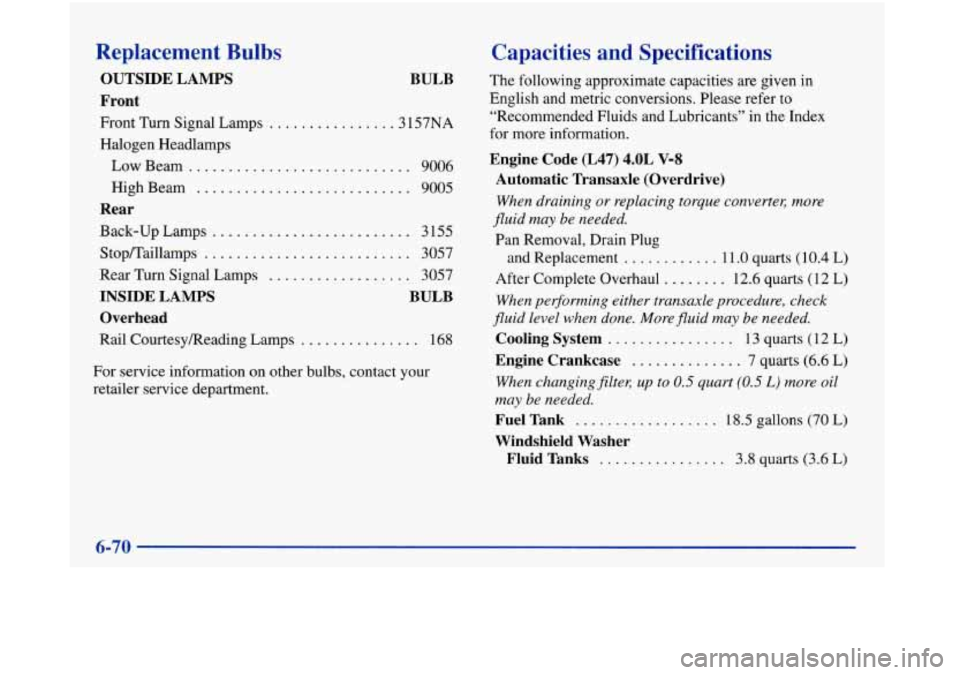
Replacement Bulbs
BULB
OUTSIDE LAMPS
Front
Front
Turn Signal Lamps ............... .3 157NA
Halogen Headlamps
Low Beam
............................ 9006
High Beam
........................... 9005
Rear
Back-up Lamps ......................... 3 155
StopKaillamps
.......................... 3057
Rear
Turn Signal Lamps .................. 3057
INSIDE LAMPS BULB
Overhead
Rail CourtesyReading Lamps ............... 168
For service information on other
bulbs, contact your
retailer service department.
Capacities and Specifications
The following approximate capacities are given in
English and metric conversions. Please refer to
“Recommended Fluids and Lubricants” in the Index
for more information.
Engine Code (L47) 4.0L V-8
Automatic Transaxle (Overdrive)
When draining or replacing torque converteq more
fluid may be needed.
Pan Removal, Drain Plug
and Replacement
............ 11 .O quarts (10.4 L)
After Complete Overhaul
........ 12.6 quarts (12 L)
When per$orming either transaxle procedure, check
fluid level when done. More fluid may be needed.
Cooling System ................ 13 quarts (12 L)
Engine Crankcase .............. 7 quarts (6.6 L)
When changingfllteq up to 0.5 quart (0.5 L) more oil
may be needed.
Fuel Tank .................. 18.5 gallons (70 L)
Windshield Washer
Fluid Tanks
................ 3.8 quarts (3.6 L)
6-70
Page 323 of 380
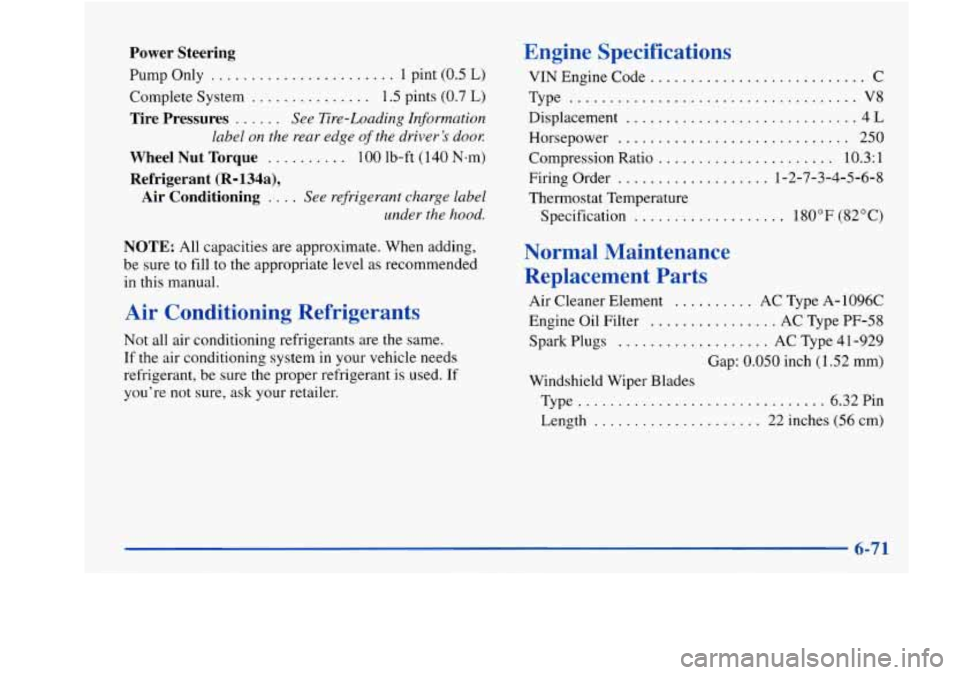
Power Steering
Pump Only ....................... 1 pint (0.5 L)
Complete System ............... 1.5 pints (0.7 L)
Tire Pressures ...... See Tire-Loading Information
label on the rear edge
of the driver’s doox
Wheel Nut Torque .......... 100 lb-ft (140 Nam)
Refrigerant (R=134a),
Air Conditioning
.... See refrigeran.t charge label
under the hood.
NOTE: All capacities are approximate. When adding,
be sure to fill
to the appropriate level as recommended
in this manual.
Air Conditioning Refrigerants
Not all air conditioning refrigerants are the same.
If the air conditioning system
in your vehicle needs
refrigerant, be sure the proper refrigerant is used.
If
you’re not sure, ask your retailer.
Engine Specifications
VIN Engine Code ........................... C
Type
.................................... V8
Displacement ............................. 4 L
Horsepower ............................. 250
Compression Ratio
...................... 10.3: 1
Firing Order ................... 1-2-7-3-4-5-6-8
Thermostat Temperature
Specification
................... 180°F (82°C)
Normal Maintenance
Replacement Parts
Air Cleaner Element .......... AC Type A-1096C
Engine Oil Filter
................ AC Type PF-58
Gap:
0.050 inch (1.52 mm)
Spark Plugs
................... AC Type 4
1-929
Windshield Wiper Blades
Type
............................... 6.32Pin
Length
..................... 22 inches (56 cm)
Page 324 of 380
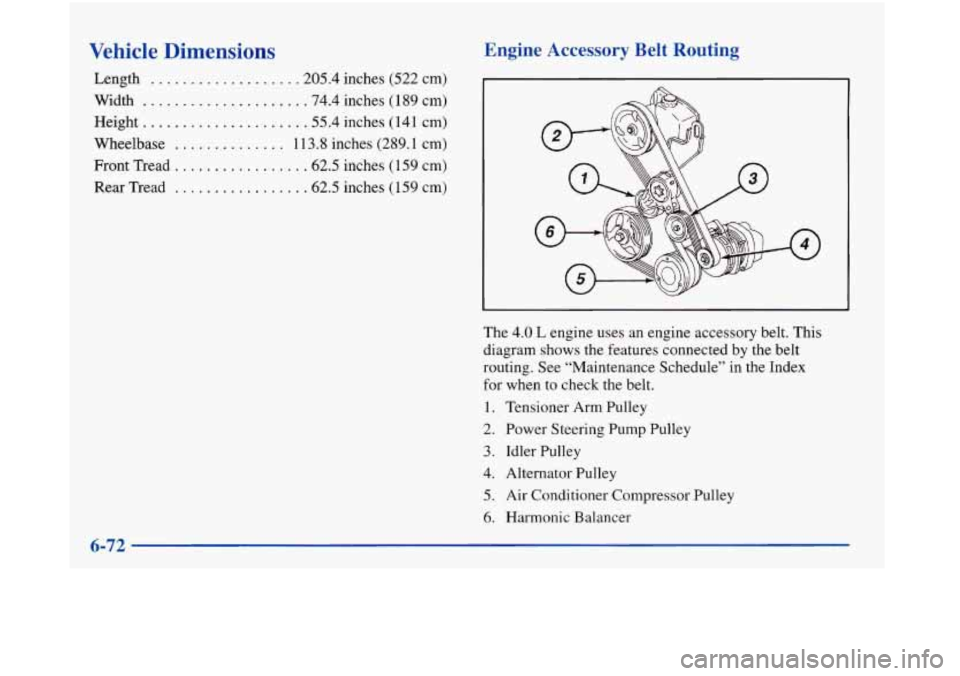
Vehicle Dimensions
Length .................. .205.4 inches (522 cm)
Width
.................... .74.4 inches (1 89 cm)
Height
.................... .55.4 inches (141 cm)
Wheelbase
.............. 1 13.8 inches (289.1 cm)
Front Tread
................ .62.5 inches (1 59 cm)
Rear Tread ................ .62.5 inches (159 cm)
Engine Accessory Belt Routing
The 4.0 L engine uses an engine accessory belt. This
diagram shows the features connected by the belt
routing. See “Maintenance Schedule” in the Index
for when to check the belt.
1. Tensioner Arm Pulley
2. Power Steering Pump Pulley
3. Idler Pulley
4. Alternator Pulley
5. Air Conditioner Compressor Pulley
6. Harmonic Balancer
Page 328 of 380

IMPORTANT:
KEEP ENGINE OIL
AT THE PROPER
LEVEL AND CHANGE AS RECOMMENDED
n=
Have you purchased the GM Protection Plan? The Plan
supplements
your new vehicle warranties. See your
Warranty and Owner Assistance booklet, or your Aurora
retailer
for details.
Introduction
Your Vehicle and the Environment
Proper vehicle maintenance not only helps to keep your
vehicle in good working condition, but also helps the
environment. All recommended maintenance procedures are important. Improper vehicle maintenance can even
affect the quality of the air we breathe. Improper fluid
levels or the wrong tire inflation can increase the level
of emissions from your vehicle. To help protect our
environment, and to keep your vehicle in good
condition, please maintain your vehicle properly.
7-2
Page 331 of 380
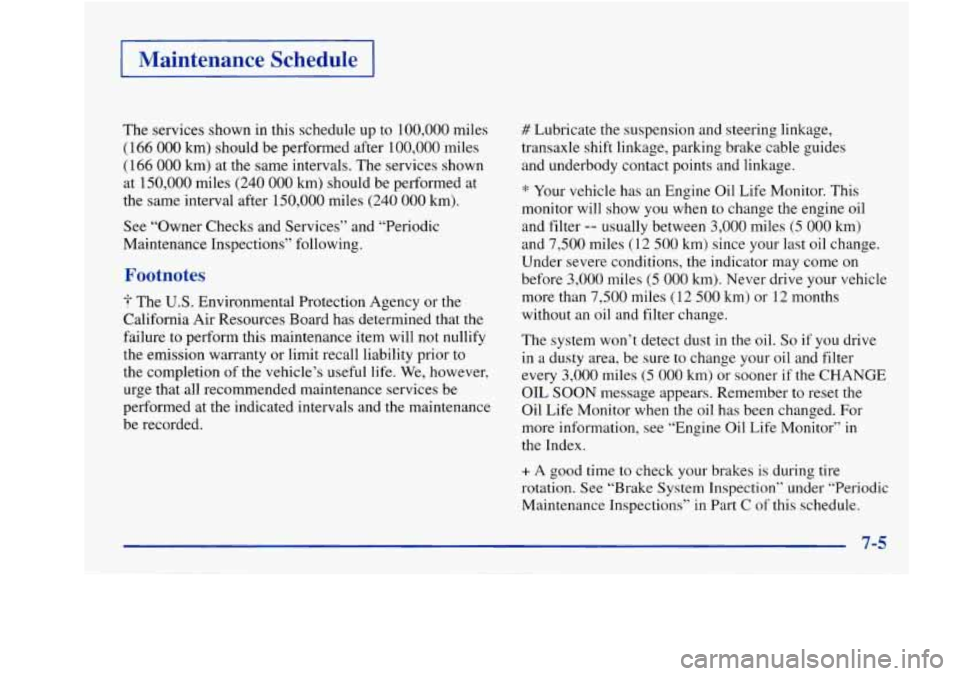
Maintenance Schedule
The services shown in this schedule up to 100,000 miles
(166 000 km) should be performed after 100,000 miles
(166
000 km) at the same intervals. The services shown
at 150,000 miles (240
000 km) should be performed at
the same interval after 150,000
miles (240 000 km).
See “Owner Checks and Services’’ and “Periodic
Maintenance Inspections” following.
Footnotes
f‘ The U.S. Environmental Protection Agency or the
California Air Resources Board has determined that the
failure to perform this maintenance item will not nullify
the emission warranty or limit recall liability prior to
the completion of the vehicle’s useful life. We, however,
urge that all recommended maintenance services be
performed at
the indicated intervals and the maintenance
be recorded.
+ A good time to check your brakes is during tire
rotation.
See “Brake System Inspection” under “Periodic
Maintenance Inspections” in Part
C of this schedule.
# Lubricate the suspension and steering linkage,
transaxle shift linkage, parking brake cable guides
and underbody contact points and linkage.
* Your vehicle has an Engine Oil Life Monitor. This
monitor will show you when to change the engine oil
and filter
-- usually between 3,000 miles (5 000 km)
and 7,500 miles (12 500 km) since your last oil change.
Under severe conditions, the indicator may come on
before
3,000 miles (5 000 km). Never drive your vehicle
more than 7,500 miles (12 500 km) or 12 months
without an oil and filter change.
The system won’t detect dust in the oil.
So if you drive
in
a dusty area, be sure to change your oil and filter
every
3,000 miles (5 000 km) or sooner if the CHANGE
OIL SOON message appears. Remember to reset the
Oil Life Monitor when the oil has been changed. For
more information, see “Engine Oil Life Monitor” in
the Index.
7-5
Page 332 of 380
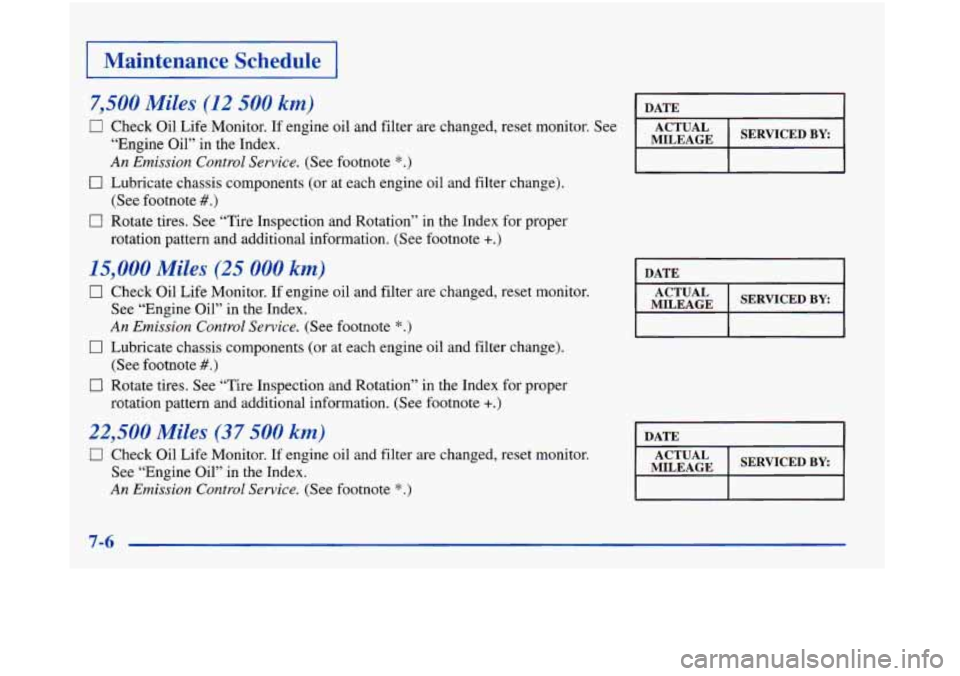
I Maintenance Schedule I
7,500 Miles (I2 500 km) DATE I
0 Check Oil Life Monitor. If engine oil and filter are changed, reset monitor. See ACTUAL
“Engine Oil” in the Index. MILEAGE SERVICED
BY
An Emission Control Service. (See footnote *.)
(See footnote #.)
0 Lubricate chassis components (or at each engine oil and filter change).
0 Rotate tires. See “Tire Inspection and Rotation” in the Index for proper
rotation pattern and additional information. (See footnote
+.)
15,000 Miles (25 000 km)
0 Check Oil Life Monitor. If engine oil and filter are changed, reset monitor.
See “Engine Oil” in the Index.
An Emission Control Service. (See footnote *.)
(See footnote #.)
rotation pattern and additional information. (See footnote +.)
0 Lubricate chassis components (or at each engine oil and filter change).
0 Rotate tires. See “Tire Inspection and Rotation’’ in the Index for proper
22,500 Miles (37 500 km)
0 Check Oil Life Monitor. If engine oil and filter are changed, reset monitor.
See “Engine Oil” in the Index.
An Emission Control Service. (See footnote *.)
I I I
I
DATE I
DATE 1
I MILEAGE ACTUAL I SERVICEDBY: I
7-6
Page 333 of 380
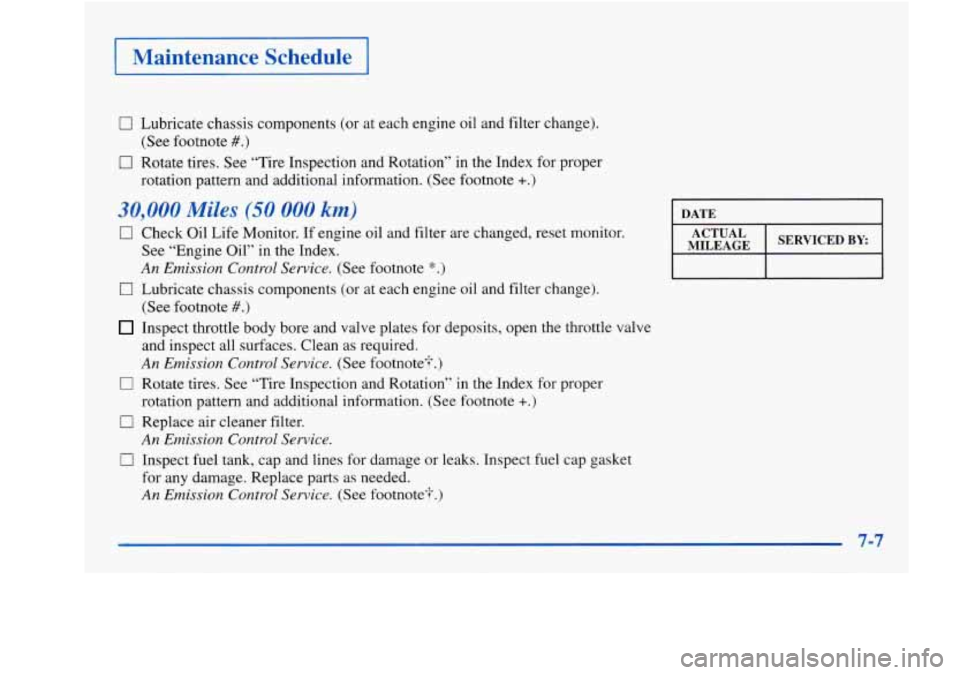
1 Maintenance Schedule I
0 Lubricate chassis components (or at each engine oil and filter change).
0 Rotate tires. See “Tire Inspection and Rotation” in the Index for proper
(See footnote
#.)
rotation
pattern and additional information. (See footnote +.)
30,000 Miles (50 000 km)
0 Check Oil Life Monitor. If engine oil and filter are changed, reset monitor.
See “Engine Oil” in the Index.
An Emission Control Service. (See footnote *.)
(See footnote #.)
and inspect all surfaces. Clean as required.
An Emission Control Service. (See footnote?.)
rotation pattern and additional information. (See footnote
+.)
An Emission Control Service.
for any damage. Replace parts as needed.
An Emission Control Service. (See footnote?.)
0 Lubricate chassis components (or at each engine oil and filter change).
Inspect throttle body bore and valve plates for deposits, open the throttle valve
0 Rotate tires. See “Tire Inspection and Rotation” in the Index for proper
0 Replace air cleaner filter.
0 Inspect fuel tank, cap and lines for damage or leaks. Inspect fuel cap gasket
DATE I
I MILEAGE ACTUAL I SERVICEDBY: I
7-7